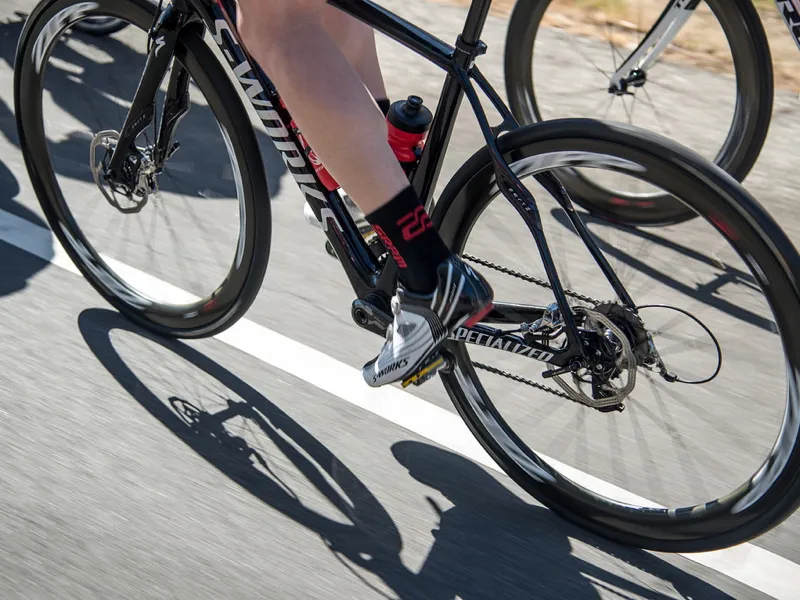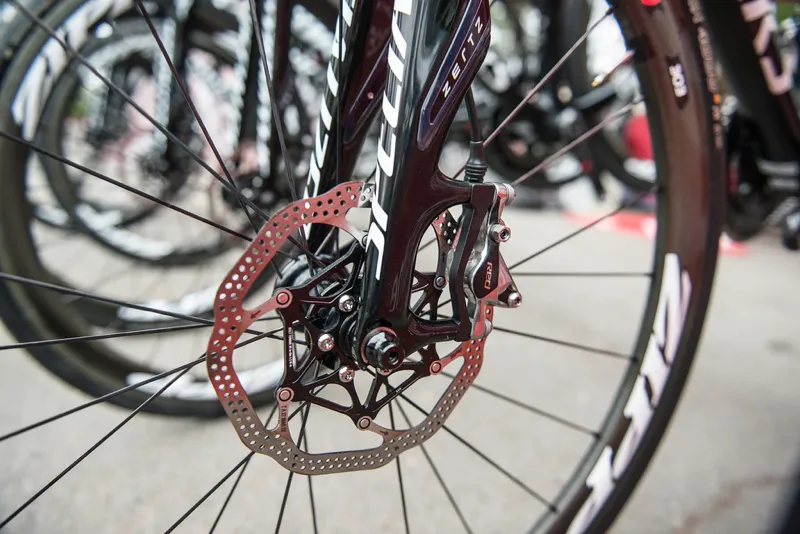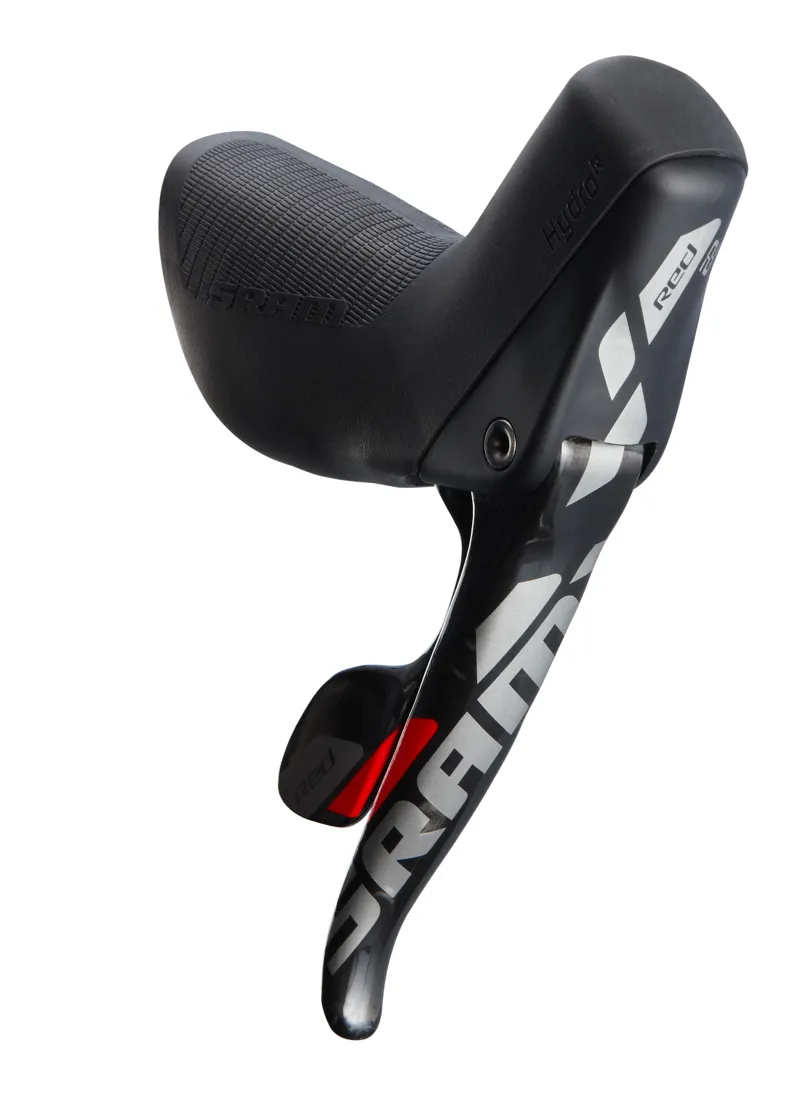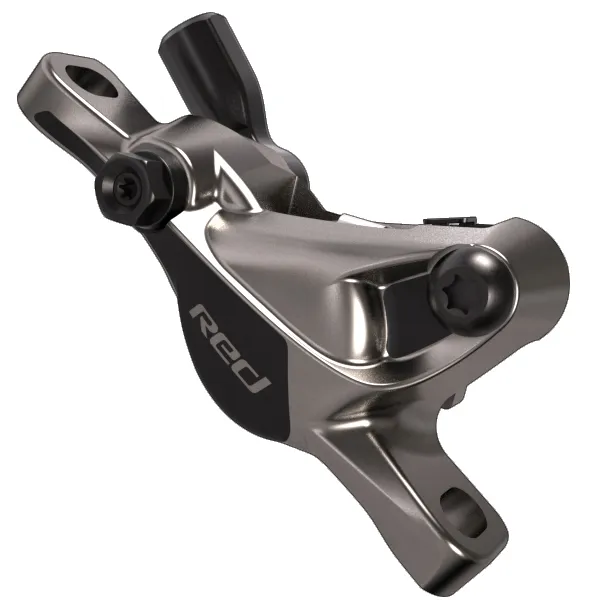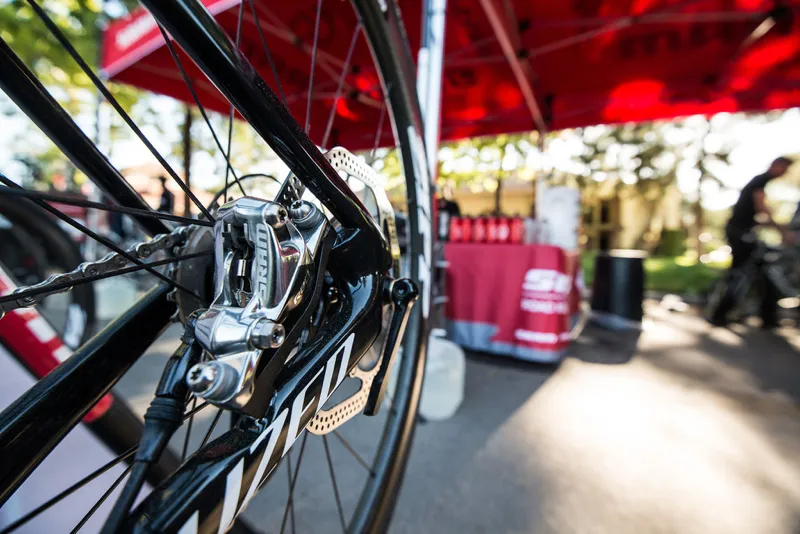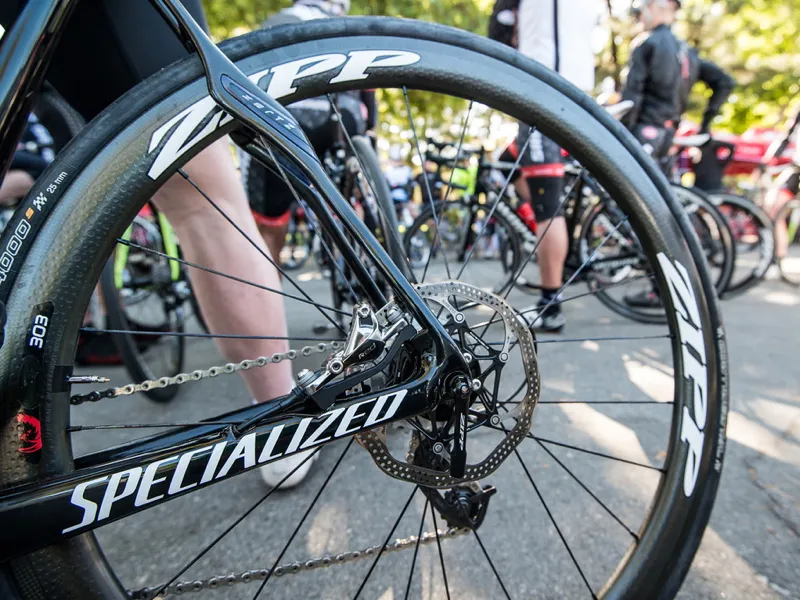The SRAM Red 22 road group has three braking options: standard mechanical plus hydraulic rim and hydraulic disc calipers. Here we take a look at the disc option, which uses Red 22 Hydro R hydraulic brake/shift levers along with the rest of the standard Red 22 parts kit and weighs in at 2119g.
Compared to the SRAM Red 2012 group, there are two major changes with Red 22: an 11-speed cassette and the optional hydraulic shift levers and calipers. While the derailleurs, cranks and chain have been calibrated for 11-speed and given a cosmetic lift, the fundamental designs are the same. With that in mind, we’ll focus primarily on the big news here, the hydraulic braking, and address the mechanical components in the next review on the full-mechanical Red 22 group.
With 160mm rotors, steel-backed organic pads and an open hydraulic system with DOT fluid, SRAM Red 22 delivers on most of the big promises of road disc brakes: great modulation, power in the dry and wet, and the elimination of heat from the (now often carbon) rim. The Red 22 hydraulic group does bring along to the road some of the negatives of disc systems, as well: weight, noise and a bit of complexity.
In test rides by two BikeRadar riders, we found the braking quality itself to be excellent, but we wished for tool-free pad adjustment and, being roadies, we were put off a bit by the various noises that popped up over the course of a few hours of riding.
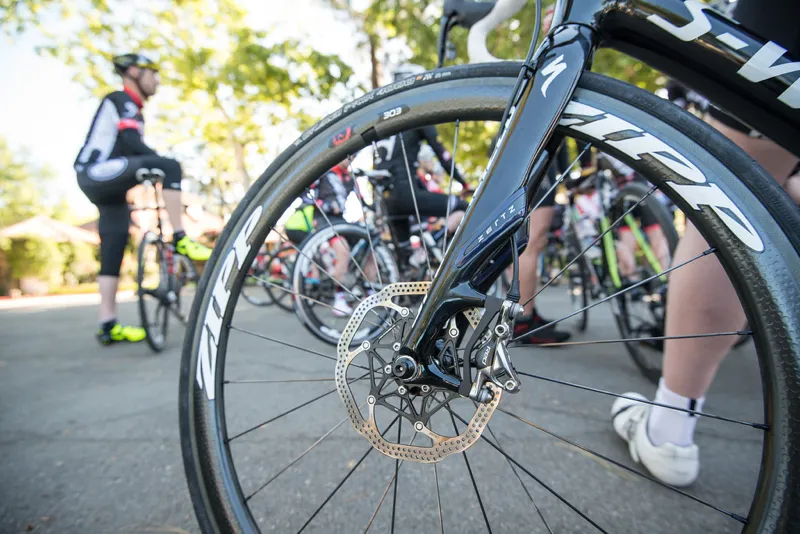
SRAM requires 160mm rotors for road riding, and specifies a 250lb bike + rider limit
Related reading
- SRAM Red 22 11-speed hydraulic, mechanical group: Full details
- SRAM Red 22 groupset: First ride review
- SRAM Red 22 Hydraulic Rim groupset: First ride review
- Hydraulic road brakes: What's the point?
- UCI open-minded about disc brakes for pro peloton
Lever feel: Strong braking via gentle force with plenty of throw
If you are expecting the slightest movement of the brake levers to nearly lock up wheels with a mighty force, you’ll be disappointed with Red 22. But, as Avid’s Paul Kantor points out, brakes that are quick to grab are not good brakes, and this was not the target with Red 22.
Instead, the system has a large amount of movement at the lever compared to the small but powerful and even movement at the caliper. This is where the great modulation comes from.
The slight amount of force required to pull the levers is immediately noticeable, as is the silky smooth feel throughout stroke.
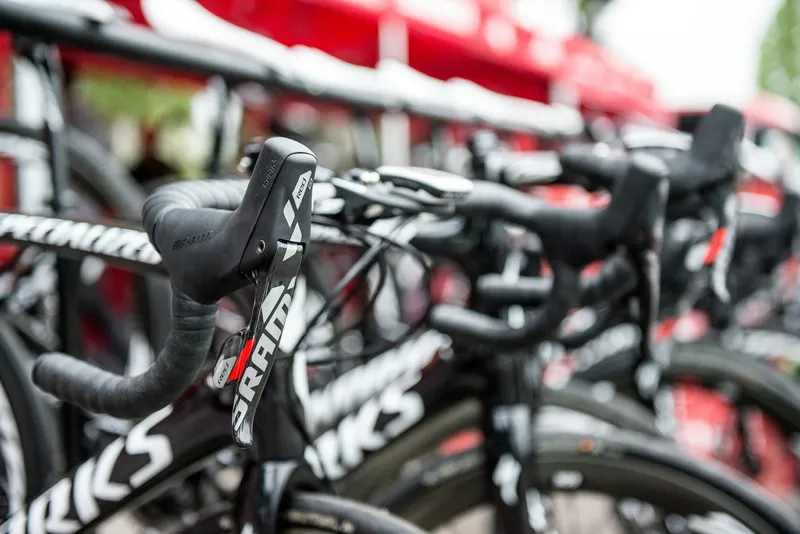
Red 22 Hydro R levers feature a hydraulic cylinder atop the 11-speed lever
Because it's so easy to pull the levers, the brakes felt soft in our hands. The first few times into a tight downhill corner, it felt like we weren't braking hard enough with our fingers, despite the fact that the bike was clearly decelerating rapidly. To be clear, the levers did not get spongey or squishy; they are just easy to operate.
During two test rides that included a total more of more than 4,000 feet of windy descending, we had ample opportunity to test the brakes under relatively challenging conditions. In fact, we had a real-life panic stop on one descent; whipping around a downhill corner at about 35mph, we found a police car stopped dead in the road. We — and the riders behind us — quickly and safely came to a standstill without any skidding. (Full disclosure: there was some squealing... mostly from the riders.)
Brake performance: Even, predictable power throughout
SRAM has a 250lb limit for bike-and-rider weight for the system and specifies that 160mm rotors be used front and back. Our test riders are in the 185-190lb range, and our bikes were about 17lbs. While we did not drag the brakes down entire mountain descents, we did use them aggressively and repeatedly to brake from 35mph or 40mph down to 15mph for sharp turns or all the way to a stop. Throughout a few hours of riding and a few thousand feet of descending, the Red 22 Hydro R brakes performed predictably without any fade.
One element were unable to test was performance in the wet. But given our experience with mountain bike disc brakes in the rain, the Red 22 discs should work as well as they do in the dry. It is here where road discs promise gain over standard wheels, especially those with carbon brake tracks, as even the very best pad/carbon brake track combination does not immediately engage in the rain.
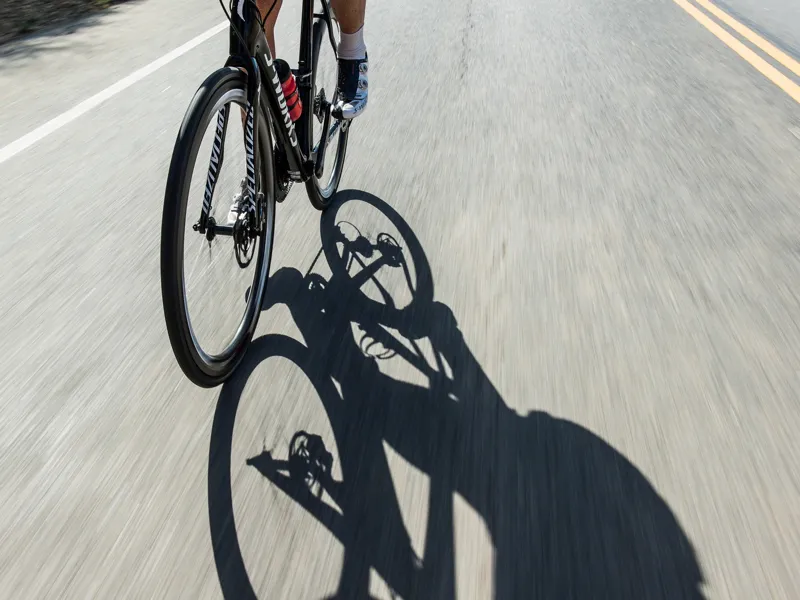
Hydro R discs brake change the look, feel and sound of the road bike experience
Disc noise: Sounds different to rim brakes
There is no getting around the fact that disc brakes add a new catalog of sounds to the road bike experience. Whether the occasional squeal after hard braking or just a soft metallic scratching when gently coming to a stop at a traffic light, the Red 22 Hydro R disc brakes sound nothing like what you are accustomed to on a road bike.
Also, having a rotor slightly out of adjustment can result in a sound mountain bikers are familiar with – a light rhythmic tinging. On one of our rides, an adjacent rider’s wheel kicked some debris into our front wheel, prompting the ‘ting, ting, ting’ for the next few miles of our ride. Which brings us to the lack of tool-free adjustment.
No tool-free adjustment: A strike against everyday usability
The Hydro R rim calipers have a barrel adjuster that looks and functions similarly to a mechanical barrel adjuster: twisting it with your fingers moves the brake pads closer or farther away from the rim. The Hydro R disc caliper has no such adjustment. This means that, should you need to back off the pads for whatever reason, such as a mid-ride incident, you cannot do so without tools.
This isn’t a deal breaker, but it certainly is a step backwards as far as everyday usability.
Weight: 463g heavier than Red 22 mechanical
Hydraulic disc systems add weight. For the Red 22 Hydro R discs, it comes to an additional 463g over the Red 22 mechanical group when you take into account the rotors and the additional weight of the wheel (using Zipp 303 standard and disc carbon clinchers for comparison). Arguably, the frames could also increase in weight to account for the additional stability required at the fork leg and rear triangle.
Pricing: Slightly more expensive than Red 22 mechanical
The hydraulic system add some expense as well as weight. Suggested retail for a full Red 22 group with Hydro R disc calipers is €2,443/£2,180/$2,747. This does not include the rotors, which range from €39/$35/£44 for HS1 to €64/$60/£72 for HSX with titanium bolts.
Bottom line: A fundamentally different braking experience
Kudos to SRAM for bringing new options to road braking in an integrated package. The Hydro R disc brakes alter the experience of modulating speed on a road bike — and mostly in a good way. As with anything, there are balances of characteristics. With SRAM Red 22 with Hydro R disc brakes, you get a powerful, all-conditions braking system with great modulation, but you give up some ease of use (and compatibility with all your current road wheels), and you add in some heft and a few new noises to your riding experience.
